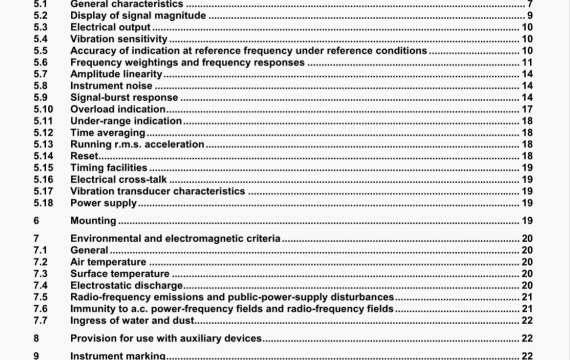ISO 8041 pdf download – Human response to vibration —Measuring instrumentation.
For each frequency weighting provided, a steady sinusoidal electrical signal shall be applied to the electrical input facility at the appropriate reference frequency. With an input signal adjusted to indicate the reference vibration value on the reference measurement range with band-limiting frequency weighting, the indicated frequency-weighted vibration values shall equal the indicated band-Imited weighted vibration value multiplied by the appropriate weighbrig factor (see Table 1) within the tolerance limits of Table 2. The maximum expanded uncertainties of measurement are 2 %.
For an instrument where time weoghtings are provided, a steady sinusoidal electrical signal shall be applied to the electrical Input facilty at the reference frequency. The amplitude of the Input signal shall be adjusted to give an Widication of the reference vibration value on the reference measurement range with the vibration meter set to band-limiting frequency weighting. With the same input signal. the indicated vibration values on each time weighting shall equal the indicated reference vibration value within the tolerance limits of Table 2. The maximum expanded uncertainties of measurement are 2 %.
12.8 ElectrIcal cross-talk
For instruments with more than one measurement channel (e.g. tflaxial measurement instruments), tests shall be carried out of the electrical rleiterence between the channels.
All channels shaM be set to the reference measurement range. An electrical input shall be appbed to each channel In turn at the reference frequency the Inputs to all remammg channels shall be terminated by substitute impedances The amplitude of the test signal shall be within the upper 5 dB of the reference range. The output of all channels shall be monitored during the tests.
The output from all channels shall not exceed the requirements of 5.16.
12.9 Vibration transducer
The vibration transducer charactenst.cs (Annex E) of the accelerometer shaM be tested according to the
relevant parts of ISO 5347 and ISO 16063
12.10 Amplitude linearity and under-range indication
12.10.1 ElectrIcal tests of amplitude linearity
The electrical tests of amplitude linearity of an instrument shaM be carried out with steady sinusoidal electrical signals at the frequencies indicated in Table 14. Amplitude linearity shaM be tested with the Instrument set to time-averaged measurement with a band-limiting frequency weighting.
EXAMPLE An instrument provides two whOlo.body weightags: P4 and Ilk. Ii is selected Icc both mechanical and electrical frequency response testing The response of the vibration transducer Is ven by the difference between the mechanical and electrical lest results icc W. This ibrabcn transducer response is added to th. electrical response for lf to give the over trequency response of Sw Iwirumant tow II
For all avadabte frequency weightings. the error of the overal frequency response of the instrument shall be within the apptcable tolerance limits specified In 5.6. The maximum expanded uncertainties of measurement are 5 % for all frequencies in the appropriate nominal frequency range
Other optional frequency responses provided shall conform to the design goals and tolerance limits stated in the instrument documentation.
12.12 Instrument noise
The typical value of instrument noise shall be detemwied from the arithmetic average of ten measurements with the vibration transducer of the instrument fitted to a non-vibrating ob,ect that does not add significantly to the indicated vibration value. Tests shall be carried out for both time-averaged and time-weIghted vibration. For time-averaged human vibration, the averaging time shall be stated and shall be at least I mw for hand-arm vibration. 5 mm for whole-body vibration, and 30 mr for low-frequency whole-body applications.
12.13 Signal-burst response
Wfth the instrument set to the reference measurement range and the applicable band-l.milrig weighting, a steady slnusotdal electncal signal at the frequency specified in Table 6 shaft be applied and the signal value adpusted to obtam an indication at 50 % of the speolfeed upper boundary of the hnear operating range. The signal-bursts specified wi Table 6 shall then be applied to all avaiLable time and frequency weightings.
The tall time of the saw-tooth burst wave shall be no more than 11(512). where ‘2 is the upper muting frequency of the band-limiting component of the appropriate frequency weighting, defined ii Table 3.
Hit-frequency switching transients may be produced when generating the saw-tooth wave, To avoid the test being affected by these, a single-pole low-pass fitter may be necessary between the signal generator and the instrument under lest. The cut-ofl frequency should be high enough to avoid influencing the last results (e.g. lOOfz),
Measurements of signal-burst response shall be repealed with the value of the steady input signal reduced by factors of 10 down to an input signal value that gives an indication at least three times greater than the specified lower boundary for the linear operating range.
Measurements of sine cycle signal-burst response shall be repeated with the magnitude of the signal bursts Increased until the first indication of overload.
ISO 8041 pdf download – Human response to vibration —Measuring instrumentation
